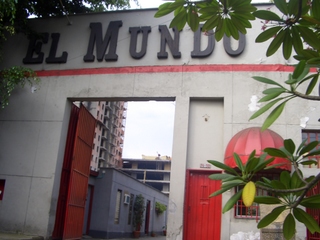Asia´s Media Innovators
Janala means “window” in Bangla. Janala offers hundreds of three-minute audio lessons and quizzes – delivered via text message (SMS) – for about 7 cents American per lesson. People in Bangladesh get access to a range of capacity-programmes via their mobile phone. The Australian Professor and Journalist Stephen Quinn has just finished a new study on innovations in Asia´s Media. The MDG-Media-Blog interviewed him on the most important foundings.
What are the most striking findings of your analysis on “Asia´s Media Innovators”?
Stephen Quinn: Many pockets of innovation have emerged in Asia’s media in the past few years. From South Korea to Indonesia, through to India and China, vibrant examples of innovative media companies are making a mark, underscoring the relationship between technology and media.
But for innovation to develop further, appropriate physical and human infrastructure must exist. The journalists who produce the content need higher levels of education and professionalism. Both journalists and their employers need to embrace the idea that learning is a life-long process, rather than something that ends with graduation from high school or university. In the general population, literacy rates affect the market’s ability to absorb the content that media companies produce, while income levels determine the audience’s capacity to buy televisions, computers, mobile phones and Internet access. Generally, the better the broadband infrastructure the more sophisticated and innovative the multi-media journalism via the web. It is the same with the human or “soft” aspects of culture; generally the better educated the journalists and the higher the levels of freedom of expression, the better the journalism.
Of the nations discussed in my book Asia’s Media Innovators, it should be noted that Malaysia, China and Singapore do not have a free press, while India, Thailand, the Philippines and South Korea have a vibrant and free press. So it can be argued that another key infrastructure is the degree of freedom of expression available to journalists, along with the availability of information and relevant freedom of information legislation.
The case of Indonesia shows what can happen when the media environment is liberalised. Until the fall of Suharto in 1998 the country’s media were heavily regulated, with a handful of owners linked to powerful families controlling the scene. Under Suharto, newspapers needed a licence and only those that toed the official line were given one. In 1998 the country had fewer than 300 newspapers and radio was also tightly controlled. During most of Suharto’s rule the country had one government channel and just three private networks controlled by his children. In the year’s since Suharto’s departure, and the arrival of democracy, Indonesia now has more than 2,000 newspapers and had experienced massive growth in radio broadcasting. By 2007 the country had 10 commercial television networks.
One of the policy implications of the research I have conducted in this area is the need for governments to focus on education and training as it relates to information and communication technologies (ICT). South Korea provides a classic example of this correlation between education and economic growth. It has almost no natural resources, but it does have a high respect for education and a diligent population: A greater percentage of Koreans go from high school to university and from university to graduate school than anywhere in the world. Measured by gross domestic product (GDP), South Korea is a developed nation. Yet when the Japanese occupation ended in 1945, its economy was a basket case. Much of the country’s infrastructure was destroyed during the Korean War from 1950-53. As late as 1960, South Korea’s per capita GDP lagged behind countries like Nigeria and Bangladesh.
The future is bright for Asian media companies that embrace technology and innovation, in a region whose future is promising if a little unclear. “Asia is set to shape the future of globalisation,” said Professor Brahma Chellaney, of the Centre for Policy Research, in Delhi. The new great game we were witnessing could well influence the future world order, he said. Historically Asia has been affluent. About 150 years ago, China and India provided 50 per cent of global GDP. But Asia missed out on the fruits of the industrial revolution. As the new century unfolds, Asia has returned to a dominant position and now represents 40 per cent of global GDP. Asia has 60 per cent of the world’s population.
What new approaches of reporting did you notice and how did it change journalistic work and content?
Stephen Quinn: I noted a range of new approaches using new digital technologies. Newspapers in Malaysia, for example, distribute news via text messages, and make money from that approach. In Thailand, some newspaper reporters blog and the blogs associated with the newspaper and good editorial content have prospered. Journalists at OhmyNews in South Korea use wibro, high-speed broadband Internet available across the nation, to broadcast live television via the web of major news events. I am writing the second volume of Asia’s Media Innovators, and I have noted the extensive use of social media and social networking in the region. This, too, is leading to innovative forms of newsgathering, such as the use of mobile phones for newsgathering. This is the subject of another book, which was published late last year. Details of that book can be found in my sig below.
In what ways did innovative journalism impact public opinion and also political life?
Stephen Quinn: One key policy implication of citizen-generated content is an appreciation of the power of the mobile phone to deliver still and moving images, and the power of images that can be damaging to individuals whose indiscretions are caught on camera.
Probably half of the world’s population now has a mobile phone, and about half of those phones contain a camera. Soon virtually all mobile phones will have a camera. Asia is expected to be the biggest growth market for mobile phones in the next few years, effectively turning society into a huge potential newsgathering force, capable of photographing anyone.
As of early 2010 China had at least 730 million mobile subscribers. This was almost double the number of Internet users (384 million as of the end of 2009). So it seems natural to combine mobile phones with education. We are seeing some innovative approaches to education in places like Beijing and Bangladesh. This is the one of the subjects of volume 2.
In India, the number of mobile phone subscribers reached 392 million as of April 2009. Most Indians prefer sending text messages (SMS) instead of calling because it is cheaper. People use texts for a wide range of reasons, including checking their bank balance, paying bills, and checking the status of trains and flights. Data from the Telecoms Regulatory Authority in India (TRAI) in late 2009 showed Indians sent an average of 29 SMS a month. If we multiply 29 by the ever-growing number of mobile phone subscribers we get an idea of the huge number of SMS that Indians generate.
Globalised communication increased pressure on newsgathering. The gap between citizen journalism and professional journalism remains huge. How can good quality journalism be maintained under these conditions?
Stephen Quinn: One of the major developments in the region’s media is the growth of audience-generated content, what some people call citizen journalism. The mainstream media partners with its audiences, and publishes and broadcasts content from citizens. Contributors usually do not get paid. Probably the most developed example is “Stomp” in Singapore. “Stomp” stands for “Straits Times online mobile and print.” About 75 to 80 per cent of the site’s content comes from its audience. Stomp was an alternative voice, said Felix Soh, who is responsible for online media with the parent company, Singapore Press Holdings (SPH). “Stomp is not serious journalism in the form that The Straits Times offers,” Soh said, “though it does deal with journalism that affects people’s lives.”
Contributors phone, email or send SMS to Stomp, then site producers interview the contributors and re-write the story. Then editor Jennifer Lewis said Singapore academics believed this behaviour was unique to Singapore, where citizens would rather talk to a reporter than write the material themselves. “When we post the story we tell the citizen journalist to read it and check it for accuracy. If it doesn’t reflect what you meant to say, call us back and we’ll adjust it.” Lewis said this approach was different from how citizen journalism worked elsewhere, such as at the pioneering OhmyNews citizen journalism site in South Korea. “Much of what we are doing is new to everybody, and given some of the cultural preferences here, our audiences would rather relate their story (to a reporter).”
The use of citizen journalism varies from country to country in the region, and could easily be the subject of a separate book. That is because of the range of forms of citizen journalism; like culture, citizen journalism varies in each country depending on a range of cultural, social, technical and economic factors.
How could innovation in media work counteract negative global trends as for instance: superficiality, decontextualisation and comodification of news?
Stephen Quinn: Many of the media innovations in Asia over the past few years have involved new uses for the mobile phone, which will or has liberated many people. For example, more than one million English lessons have been downloaded to mobile phones as part of the BBC’s Janala service. Janala means “window” in Bangla. Janala offers hundreds of three-minute audio lessons and quizzes – delivered via text message (SMS) – for about 7 cents American per lesson. People in Bangladesh get access to a range of classes via their mobile phone. The BBC has also set up a website giving learners free access to content: www.bbcjanala.com Janala launched in November 2009. It is aimed at young people living on less than $4 a day. Each session costs 3 taka, or about 4.5 American cents. Between November 2009 and February 2010, 1,030,583 Janala lessons have been accessed. More than two-thirds of people who use the beginners’ service returned to it, the BBC said. Overall, 39 per cent of callers returned to Janala. About 50 million people have mobile phones in Bangladesh, in a population of 156 million. Bangladesh has the highest population density in the world, at about 1,229 people per square kilometer.
China has more people learning English than any other country in the world. Mobile phones are popular ways to access information in China. As of early 2010 China had at least 730 million mobile subscribers. This was almost double the number of Internet users (384 million as of the end of 2009). So it seems natural to combine mobile phones with education. Early in 2010 the Pearson publishing group and phone maker Nokia formed a joint venture to teach English to people in China via the mobile phone. The new venture between Pearson and Nokia is called Beijing Mobiledu Technologies. As of early 2010 Mobiledu had about 20 million subscribers and 1.5 million active users each month. Most people use the service to improve their career propsects.










